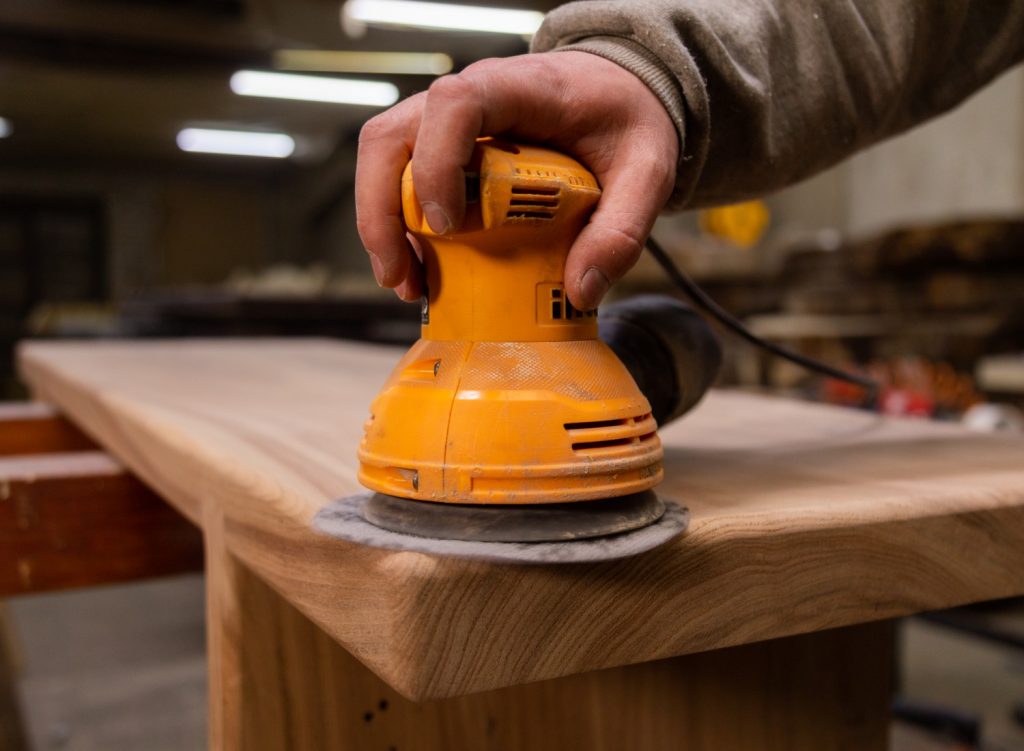Belt Sander vs. Orbital Sander: Variations of Each and When to Use Them

When it comes to the realm of sanding wood or other surfaces, the importance of having the right tool for the job cannot be overstated, as it can be a critical factor in achieving a smooth, polished finish. In the arsenal of sanding tools, two heavyweights often take center stage: the belt sander and the orbital sander.
These two sanders are distinct in design and purpose, each tailored to specific tasks and offering unique advantages in their own right. In this post, we’ll provide you with a deep understanding of when and how to employ these sanders effectively. Armed with this knowledge, you’ll be able to make informed choices, ensuring your projects result in professional-level finishes with ease and precision.
Belt Sanders
- Stationary Belt Sander: This type of belt sander is typically larger and designed to stay in one place, often mounted on a workbench or table. It’s excellent for heavy material removal and precision sanding on large, flat surfaces.
- Handheld Belt Sander: Handheld belt sanders are portable and versatile. They come in various sizes and are suitable for tasks like shaping, leveling, and smoothing surfaces, such as doors, tabletops, and floors.
When to Use a Belt Sander
Belt sanders excel at material removal, offering high efficiency in swiftly eliminating substantial material. They’re invaluable for tasks like leveling uneven surfaces, stripping paint or varnish, and addressing rough wood.
For extensive, flat surfaces, stationary belt sanders prove their worth. They are ideal for sanding wide boards, tabletops, or countertops. Meanwhile, handheld models are perfect for intricate detail work on these large surfaces.
When equipped with finer grit belts, belt sanders transition seamlessly into precision work, aiding in fine finishing and shaping tasks. When you’re dealing with rough-cut lumber and need to swiftly eliminate imperfections, a belt sander is an indispensable tool for achieving a smoother, more refined surface.
Orbital Sanders
- Random Orbital Sander: This popular type of orbital sander moves in a circular, random pattern to prevent swirl marks on the surface. It’s versatile and suitable for a wide range of tasks.
- Sheet Sander (Finishing Sander): Sheet sanders use rectangular sandpaper sheets and move in a straight-line, back-and-forth motion. They are excellent for precise finishing work.
When to Use an Orbital Sander
Orbital sanders shine in the realm of finish sanding, making them superb tools for achieving smooth, polished surfaces before applying paint, varnish, or finish. These versatile sanders are particularly effective in the removal of scratches, swirl marks, or imperfections from a surface without introducing new blemishes. Their finesse also extends to the domain of furniture and woodwork refinishing, allowing for the meticulous restoration of cabinets and furniture.
Furthermore, when dealing with curved or contoured surfaces that demand precision and control, sheet sanders step into the spotlight, offering an ideal solution for achieving flawlessly smooth results on these intricate and challenging areas.
Choosing Between a Belt and Orbital Sander
When selecting the right sander for your project, several key factors should be taken into account. Firstly, consider the material you’re working on and the specific task at hand. If you’re dealing with heavy material removal or smoothing extensive, flat surfaces, a belt sander proves to be the better choice.
On the other hand, if you’re engaged in finish sanding, focusing on smaller areas, or working on curved surfaces, an orbital sander is the more suitable option. Versatility is another crucial consideration. For those seeking a sander that can handle a variety of tasks, a random orbital sander stands as a great all-around choice.
The choice between precision and speed should also be weighed: orbital sanders are synonymous with precision and delivering a finer finish, while belt sanders prioritize speed in material removal. Take into account the size of your project and your workspace, as belt sanders come in various sizes, so selecting one that suits your specific needs is essential.
Lastly, consider the importance of dust collection, as both belt and orbital sanders can produce substantial dust. It’s advisable to seek models with effective dust collection systems or employ a dust extractor to maintain a clean and safe workspace.
Conclusion
Belt sanders and orbital sanders each have their strengths and are designed for specific tasks. Understanding their variations and when to use them will empower you to choose the right tool for your woodworking or DIY projects. Whether you’re leveling a tabletop, smoothing a wooden floor, or refinishing a cherished piece of furniture, having the appropriate sander on hand ensures that your work is not only efficient but also yields professional-quality results. So, the next time you embark on a sanding project, you’ll be well-equipped to achieve that smooth and polished finish you desire.
